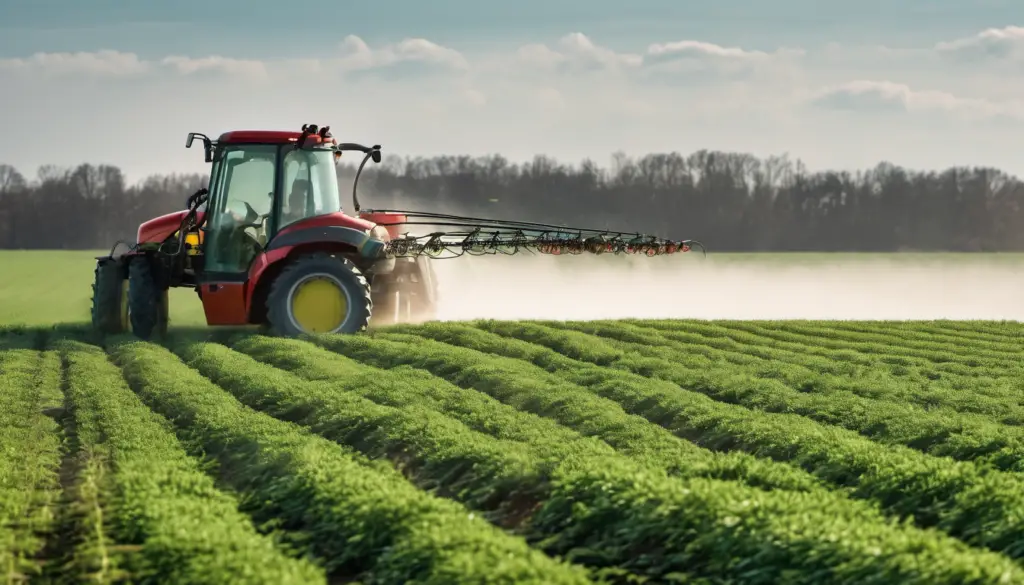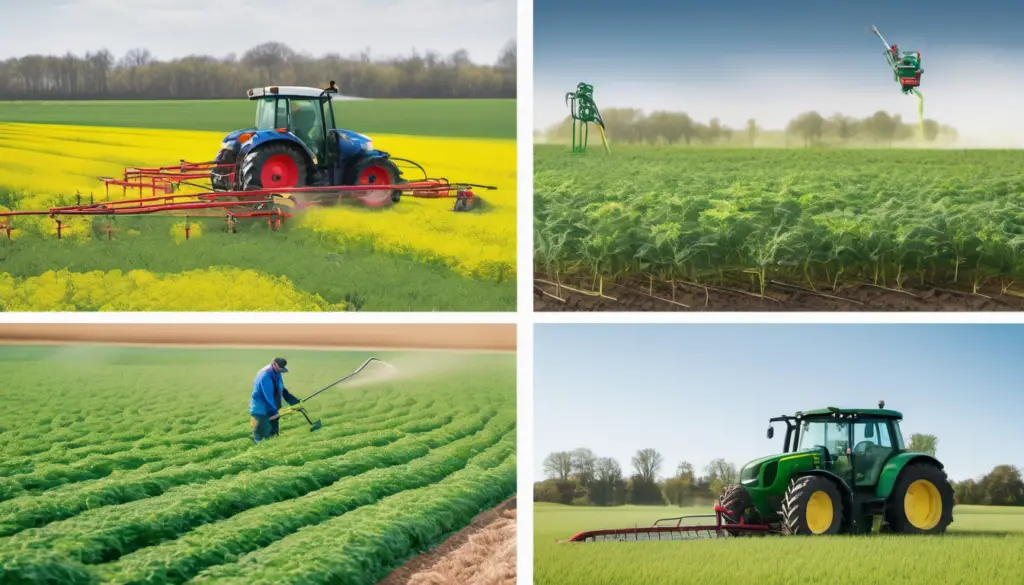In commercial farming, effective weed control is vital for ensuring healthy crops and profitable yields. Weeds, competing with crops for resources like water, nutrients, and sunlight, can significantly reduce crop quality and quantity. Additionally, they may harbor pests and diseases, complicating farming operations and increasing costs. This article delves into various weed control strategies, from understanding weed types and life cycles to adopting integrated methods, offering insights for farmers to effectively manage weeds and maintain sustainable, productive farms.

Understanding Weeds in Commercial Farming
Weeds come in various forms and sizes, each with its unique characteristics and impacts on farming operations. Common weeds found in commercial farms include species like crabgrass, dandelions, thistles, pigweed, and Johnson grass. These weeds are not only hardy but also possess traits that enable them to thrive in agricultural environments, often to the detriment of the cultivated crops.
The lifecycle of weeds is a key factor in their control. Many weeds are known for their rapid growth and reproduction rates. Some produce a high number of seeds, which can remain dormant in the soil for years before germinating. Others may have persistent root systems that enable them to regenerate even after the above-ground parts are removed. Understanding these life cycles is crucial because it helps in determining the most effective timing and methods for weed control. For instance, targeting weeds before they set seed can significantly reduce future infestations.

However, controlling weeds is not without its challenges. One of the major issues faced by commercial farmers is the development of resistance to herbicides. Repeated use of the same herbicide can lead to the selection of resistant weed strains, rendering the chemical ineffective and necessitating the use of alternative methods or newer chemicals. Additionally, environmental considerations are paramount. The impact of weed control practices on the surrounding ecosystem, including the potential for chemical runoff into water bodies and its effect on non-target species, must be taken into account.
In the next sections, we will explore the various methods of weed control, their benefits, and their drawbacks, providing a comprehensive guide for commercial farmers striving to manage weed problems effectively and sustainably.
Preventive Weed Control Measures
Crop Rotation and Its Role in Weed Control
Crop rotation, the practice of growing different types of crops in the same area across a sequence of growing seasons, is a time-honored method in agriculture. This technique disrupts weed life cycles and reduces weed pressure. Different crops compete with weeds in varying ways, and rotating crops can prevent any single weed species from becoming dominant. For example, rotating a deep-rooted crop with a shallow-rooted one can suppress different weed types that prefer specific root zones. Moreover, some crops can naturally release substances that inhibit weed growth, a phenomenon known as allelopathy.

Use of Cover Crops to Suppress Weed Growth
Cover crops, planted during times when the soil might otherwise be bare, play a significant role in weed suppression. These crops, such as rye, clover, or buckwheat, establish a canopy that competes with weeds for light and nutrients, effectively reducing weed establishment. Additionally, cover crops can improve soil health, which indirectly affects weed growth patterns. When decomposed, these crops add organic matter to the soil, enhancing its structure and fertility, thus supporting the growth of desired crops over weeds.
Soil Management Practices to Prevent Weed Emergence
Effective soil management is another preventive strategy against weeds. Practices such as maintaining soil health through proper fertilization, pH balance, and moisture levels can promote vigorous crop growth, which naturally outcompetes weeds. Minimizing soil disturbance can also be beneficial, as tilling can bring dormant weed seeds to the surface, encouraging their germination. Conservation tillage practices or no-till farming are increasingly being adopted to maintain soil structure and reduce weed emergence.
Mechanical and Cultural Weed Control Methods
When preventive measures are not sufficient to control weeds, mechanical and cultural methods become essential. These methods, which involve physical removal or alteration of the growing environment, can effectively manage weed populations without the need for chemical inputs.
Tilling and Its Effectiveness in Weed Control
Tilling, the process of cultivating the soil, can be an effective way to control weeds. It works by uprooting weeds, disrupting their growth, and burying weed seeds, preventing their germination. However, the effectiveness of tilling depends on the timing and the weed species. It’s most effective when weeds are small and before they have set seed. On the downside, excessive tilling can lead to soil erosion and degradation, and can bring dormant weed seeds to the surface.
Hand Weeding and Its Relevance in Modern Farming

Hand weeding, though labor-intensive, is still relevant in modern farming, particularly in organic farming systems where chemical controls are limited or prohibited. It allows for selective weed removal without damaging the crops and is especially useful in managing weeds that are close to the crop plants. Hand weeding can be combined with other weed control methods for a more integrated approach.
Mulching as a Weed Control and Soil Health Technique
Mulching involves covering the soil surface with organic or inorganic materials. It suppresses weed growth by blocking sunlight, essential for weed germination and growth. Organic mulches, such as straw or wood chips, also improve soil health by adding organic matter as they decompose. Inorganic mulches, like plastic sheeting, can also be effective in weed suppression and moisture retention. Mulching not only controls weeds but also helps in conserving soil moisture and maintaining even soil temperatures, benefiting the overall crop health.
Chemical Weed Control
Chemical weed control, particularly the use of herbicides, is a common approach in modern commercial farming due to its effectiveness and efficiency. This section provides an overview of herbicides, best practices for their application, and insights into managing herbicide resistance.
Overview of Herbicides Used in Commercial Farming
Herbicides are chemicals specifically designed to control or kill unwanted plants. They come in various forms and modes of action. Selective herbicides target specific weed species, while leaving the desired crop unharmed. Non-selective herbicides, on the other hand, kill most plant species they come into contact with. Herbicides can also be classified based on their action time: pre-emergent herbicides are applied to control weed seeds before they germinate, and post-emergent herbicides are used to kill growing weeds.

Best Practices for Herbicide Application
To maximize the effectiveness of herbicides and minimize their environmental impact, certain best practices should be followed:
- Accurate Identification of Weeds: This ensures the correct herbicide is chosen for the specific weed species present.
- Proper Timing: Applying herbicides at the right growth stage of the weed and under suitable weather conditions increases effectiveness.
- Correct Dosage and Application Techniques: Following label instructions for dosage and using appropriate equipment helps prevent over-application and drift to non-target areas.
- Rotation of Herbicides: Using different herbicides with varied modes of action over time helps prevent the development of resistance.

Understanding Herbicide Resistance and Management
Herbicide resistance occurs when weed species evolve to survive applications of herbicides that once controlled them. This is often due to the repeated use of the same herbicide or those with the same mode of action. To manage resistance, farmers can rotate herbicides with different modes of action, integrate non-chemical control methods, and apply herbicides only when necessary. Regular monitoring of weed populations for signs of resistance is also crucial for early detection and management.
Integrated Weed Management (IWM)
Integrated Weed Management (IWM) is a holistic approach to weed control that combines various strategies to manage weed populations sustainably and effectively. It is an essential component of sustainable farming.
Explanation of IWM and Its Importance in Sustainable Farming
IWM involves the integration of mechanical, cultural, biological, and chemical methods to control weeds. This approach aims to reduce reliance on any single method, particularly chemical control, to minimize environmental impact and the risk of developing herbicide resistance. IWM focuses on understanding the weed ecology in the farming system and using that knowledge to manage weed populations over the long term.

How IWM Combines Different Weed Control Methods
IWM might include practices such as crop rotation and cover cropping (cultural methods), timely cultivation and hand weeding (mechanical methods), and the judicious use of herbicides (chemical methods). By combining these methods, IWM aims to control weeds in a more sustainable, effective, and environmentally friendly way than relying on a single type of control.
Case Studies or Examples of Successful IWM in Commercial Farms
One example of successful IWM is seen in a Midwest U.S. corn and soybean farm that implemented a combination of crop rotation, cover cropping, and strategic herbicide use. This approach led to a significant reduction in herbicide applications over several years, with an accompanying decrease in weed pressure and an increase in crop yields. Another case study from Australia highlights the use of controlled traffic farming (CTF) combined with precise herbicide application, reducing weed emergence and herbicide resistance development.
These case studies exemplify how IWM, when correctly implemented, can lead to sustainable, effective weed control, benefiting both the environment and the farm’s profitability.
Conclusion: Embracing Sustainable Weed Control for a Thriving Future in Farming
In this comprehensive exploration of weed control in commercial farming, we have navigated through various strategies that underscore the complexity and importance of effective weed management. From understanding the diverse types of weeds and their life cycles to implementing preventive measures such as crop rotation, cover cropping, and soil management, we’ve seen that early and proactive approaches play a pivotal role in managing weed populations. Mechanical and cultural methods like tilling, hand weeding, and mulching offer environmentally friendly options that also contribute to soil health, while the judicious use of chemical herbicides remains a critical component, especially when practiced with attention to timing, dosage, and resistance management.
Most importantly, the concept of Integrated Weed Management (IWM) stands out as a beacon for sustainable agriculture. By combining mechanical, cultural, and chemical methods, IWM provides a balanced, environmentally conscious approach to weed control that can be tailored to specific farm needs and ecological conditions.

As we look to the future of commercial farming, the adoption of these varied and integrated weed control strategies is not just a matter of choice but a necessity for sustainable agriculture. Farmers and agricultural professionals are encouraged to embrace these practices, continually adapting and evolving them to suit their unique farming environments. For those seeking further guidance or looking to delve deeper into the nuances of weed control, consulting with agricultural experts and staying abreast of the latest research and developments in the field can provide invaluable insights.
Together, by implementing these sustainable and effective weed control practices, we can ensure the health and productivity of our farms, paving the way for a prosperous and environmentally responsible agricultural future.
